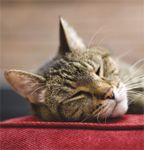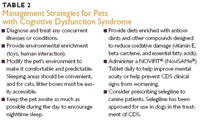Spotlight on Research: Cognitive Dysfunction Syndrome (Sponsored by Virbac Animal Health)
Pets are living longer. As a consequence, the population of dogs and cats developing signs of senility is growing.
Helping cats and dogs with cognitive dysfunction syndrome feel better and act younger
Pets are living longer. As a consequence, the population of dogs and cats developing signs of senility is growing. Cognitive dysfunction syndrome (CDS) is a disease of age-related degenerative changes in the brain similar to that seen in people experiencing Alzheimer's disease.

The clinical signs of CDS involve age-related development of behavioral changes unrelated to other medical or behavioral conditions. The most common signs associated with CDS in cats are disorientation, changes in sleep patterns, housesoiling, and changes in activity. In dogs, the changes in behavior may be more overt (Table 1).

Table 1: DISHA-Behavioral Signs of Cognitive Dysfunction Syndrome
CDS is a diagnosis of exclusion. Once systemic illnesses, organic brain disease, and true behavioral problems have been ruled out, cognitive dysfunction should be considered in older dogs and cats exhibiting signs of decreased mental acuity or dementia.
Interventions for CDS include environmental management, dietary modification, S-adenosylmethionine (SAMe) supplementation, and occasionally drug therapy* (Table 2). As with any behavioral condition, appropriate behavior modification and environmental enrichment can play important roles in optimal response. In some senior pets, even limiting their environmental scope or stimuli can improve their abilities to cope on a daily basis.

Table 2: Management Strategies for Pets with Cognitive Dysfunction Syndrome
NOVIFIT® (NoviSAMe®) Tablets are an S-adenosylmethionine tosylate supplement for cognitive health of older dogs and cats. SAMe is an endogenous molecule that stimulates cell metabolism in all tissues and has been found to be deficient in patients with Alzheimer's disease. This supplement can be more cost-effective than psychotropic drugs and has few known side effects or contraindications, making it an excellent choice for senior patients. Moreover, once-daily oral administration, with or without food, helps ensure client compliance. It is the only supplement for CDS in cats backed by scientific research.1
When your client describes one or more of the behavior changes commonly associated with CDS, it is time to have a conversation about the possible causes and long-term management strategies. The latest research confirms that, with early intervention, SAMe supplementation may delay the worsening or improve the mental acuity of affected cats and dogs.
REFERENCE
1. Araujo JA, Faubert ML, Brooks ML, et al. NOVIFIT® (NoviSAMe®) Tablets improve executive function in aged dogs and cats: Implications for treatment of cognitive dysfunction syndrome. Intern J Appl Res Vet Med 2012;10(1):90-98.
*No drugs are currently approved for treating CDS in cats.
Study of NOVIFIT® (NoviSAMe®) Tablets' effect in aged dogs and cats
Tests for assessing cognitive function have been available for dogs since 1994. Using objects and locations to evaluate cognitive abilities (such as memory, learning, and attention) makes it possible to identify cognitive differences and objectively measure response to therapy. Now those tests have been adjusted for use in cats.

In an object discrimination learning test, the dog or cat must learn that a particular object of a set of two objects is always the correct choice; by displacing the correct object (pushing it aside), a food reward is obtained. This represents basic learning. Then in reversal learning, the previously correct object is no longer rewarded, and the previously incorrect object is. This test is a measure of executive function, which is defined as a set of mental processes that help connect past experience with present action, necessary for goal-directed behavior. Executive function also includes the ability to change behavior or adapt to changing situations. This ability of an animal to alter a previously learned response has been shown to be impaired by age.1
Memory can be tested by rewarding an animal when it selects the same object even though the object appears in a different position from where it was during an earlier round of testing. Once the animal has learned that choosing the same object despite its location is rewarded, the time between the object presentations is increased in an assessment known as a DNMP (delayed non-matching to position) task. The longest delay (with a correct choice of object) represents that animal's short-term memory.
THE PUBLISHED STUDY
NOVIFIT® (NoviSAMe®) Tablets improve executive function in aged dogs and cats: Implications for treatment of cognitive dysfunction syndrome. Araujo JA, Faubert ML, Brooks ML, et al. Intern J Appl Res Vet Med 2012;10(1):90-98.
STUDY PURPOSE/OBJECTIVE
To examine the effects of NOVIFIT Tablets on cognitive function in aged cats and dogs.
ANIMALS
• 14 dogs (9.2 - 12.8 years old)
» Divided into two equivalent groups (placebo or NOVIFIT Tablets) based on performance of a DNMP task with delays of 5, 55, and 105 seconds (matched for memory).
• 16 cats (8.4-13.9 years old)
» Divided into two equivalent groups (placebo or NOVIFIT Tablets) based on performance of a discrimination learning task until the learning criterion was reached (matched for learning).
PROCEDURE
• After a 15-day wash-in, canine subjects were tested on object discrimination and reversal learning tasks and the DNMP task for five sessions. Testing lasted for a maximum of 30 days, or until the learning criterion was reached.
» Variables included treatment group and task (learning versus reversal).
• After a 15-day wash-in, feline subjects were tested on object discrimination and reversal learning tasks for a maximum of 36 days, or until the learning criterion was reached.
» Variables included treatment group and time-point interaction (an individual's change from baseline to endpoint — a within-subject variable).
• Technicians who administered the cognitive tests and conducted the observations were blinded in both studies.
RESULTS
Canine Study
• DNMP: No performance differences were found.
• Task: Both groups showed a significant difference between their tasks, from discrimination to reversal, within their group.
• Issue: Since groups were balanced for memory, and not learning, an initial difference in learning capabilities (discrimination) between the two groups could have impacted the conclusions, as there was no significant difference just looking at the treatment levels between the groups.
» Once the task and treatment interaction (combining both variables) was taken into account, the significant difference becomes apparent, as the greater relative increase in reversal learning errors in the placebo group (as compared with the treatment group) is demonstrated.
• Discrimination and Reversal: NOVI FIT Tablets improved reversal learning compared with discrimination learning.
Feline Study
• No treatment differences were seen on the learned discrimination task (balanced for learning).
• There was a non-significant trend for a treatment by time-point interaction (both variables taken into account), with a decrease in learning errors in the NOVIFIT Tablet group.
• There was a significant effect on the treatment group when "high performers" were compared (p = 0.015) with the control group. However, no treatment-related effects were found in the "bottom performers."
CLINICAL IMPLICATIONS
Canine Study
• Significant task by treatment interaction on reversal learning suggests a benefit for executive function.
» Previous studies reveal an age-related increase in reversal learning errors compared with discrimination errors — executive dysfunction.
Feline Study
• The reduction in reversal learning errors in the "high performers" treatment group is consistent with improved executive function.
» No treatment-related effect in "bottom half performers" correlates with the supposition that beneficial effects of treatment are least evident in more severely affected cats.
This study supports the use of NOVIFIT Tablets for helping to improve cognitive health in aged dogs and cats, with potential benefits on executive function, especially in the early stages of cognitive dysfunction syndrome. Moreover, this is the first published report we are aware of demonstrating cognitive benefits of a therapeutic in aged cats. Further studies may be able to define the mechanism of action and to more closely identify the groups of pets most likely to benefit from NOVIFIT Tablet therapy.
REFERENCE
1. Tapp PD, Siwak CT, Estrada J, et al. Size and reversal learning in the beagle dog as a measure of executive function and inhibitory control in aging. Learn Mem 2003;10:64-73.
For more information on NOVIFIT Tablets, click here.
Viewpoint on early recognition and treatment of cognitive dysfunction in cats
Gary Landsberg, BSc, DVM, DACVB, DECAWBM (behavior)
As we continue to learn more about cognitive function and dysfunction in cats, it is now evident that while there are similarities to the canine form of the disease, identifying the condition in feline patients can be particularly challenging. Since cats are small and agile and have adaptive mechanisms that may initially mask behavioral signs, early changes may not be recognized, or may be dismissed as a normal sign of aging. Thus, owners may not report behavioral issues until the problems are severe enough to visibly affect the well-being of the cat or the owner. Yet, early intervention appears to provide the best option for improving or slowing the progress of the condition. Besides the difficulties in recognizing early behavioral changes in cats, the stress of the veterinary visit on both the cat and the owner is probably one reason for the downturn in feline visits. In a senior cat, this stress may be even more profound.

Dr. Gary Landsberg is a veterinary behaviorist at the North Toronto Animal Clinic and director of veterinary affairs for CanCog.
Since owners are unlikely to recognize early signs of cognitive dysfunction, it is imperative for veterinarians and their staffs to be proactive. Owners should be educated that not only are early recognition and reporting of behavioral signs important in the diagnosis of cognitive dysfunction, but that changes in behavior are often the first or only indication of an underlying medical condition. For example, alterations in behavior and mobility are the primary signs of osteoarthritis in cats, and housesoiling might be the first sign of diabetes or kidney disease. While medical problems should be addressed first, with increasing age pets may develop multiple health problems. Therefore, even if medical conditions are identified, concurrent cognitive dysfunction should still be considered.
With some adjustment to account for species differences, the DISHA acronym (Disorientation, vhanges in social Interactions, Sleep-wake cycle alterations, Housetraining errors, and changes in Activity), which is commonly used to evaluate canine patients, can also be applied to cats. (See Table 1.) Additional signs in cats include:1
• Excessive vocalization — especially in the older group (15 to 21 years)
• Altered responses to stimuli — anxiety and irritability
• Decreased self-hygiene — may also be due to medical problems or pain
• Alterations in appetite — an increase or decrease; also common in many patients with medical problems
In addition to using a questionnaire to address these points during a senior cat visit, the clinic should focus on educating owners of senior cats who have not visited in a while. Prompted by educational postcards and e-mails and information on the clinic's website, owners may come to the realization that behavior changes they thought were "just old age" are really a problem that should be investigated and managed.
In fact, a recent study2 (the first of its kind, investigating therapy for feline cognitive dysfunction syndrome) showed that when NOVIFIT® (NoviSAMe®) Tablets were given to a treatment group of aged cats showing early indications of cognitive dysfunction, there was a significant improvement in age-related deficits in executive function as compared with the group receiving a placebo. Since the same improvement was less evident or absent in groups of cats that were more affected, this reinforces the importance of early detection.
REFERENCES
1. Landsberg GM, Denenberg S, Araujo JA. Cognitive dysfunction in cats: A syndrome we used to dismiss as 'old age.' J Feline Med Surg 2010;12:837-848.
2. Araujo JA, Faubert ML, Brooks ML, et al. NOVIFIT® (NoviSAMe®) Tablets improve executive function in aged dogs and cats: Implications for treatment of cognitive dysfunction syndrome. Intern J Appl Res Vet Med 2012;10(1):90-98.
Newsletter
From exam room tips to practice management insights, get trusted veterinary news delivered straight to your inbox—subscribe to dvm360.